December 2008
Well, That Happened...
Argentina Part 1
Or, as we have come to say: “Well, that happened… let’s go find some ice cream”. It was a busy December.
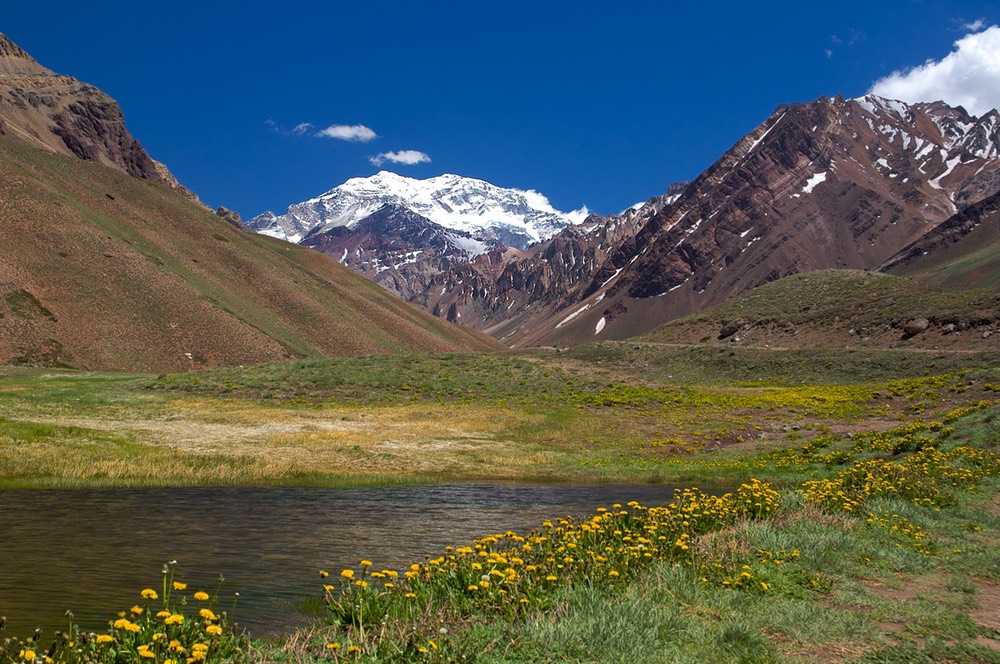
So here we are in Argentina, having just crossed in from Chile. (Why doesn’t my computer program recognize Argentina as a proper name? Why do I have to keep going back to capitalize it? Rick says I should be able to teach it to recognize Argentina as a country and automatically capitalize the word, but can you picture me teaching a computer anything? Bummer. But you don’t want to hear about all that, do you?)
After we were released by the B.B.s (you already know who they are…..) we set off to learn about this huge country. Our first stop was to visit the highest peak anywhere in the world outside of the Himalayas, Volcan Aconcagua. You can easily hike to a vantage point from which to enjoy this huge peak, and it’s well worth it. It’s December, so you need to think… June. The peak has plenty of snow, but it’s a summer alpine experience: pretty wildflowers, birds, wetlands, lots of grass. Warm enough, but brisk.
The road into the area is in the midst of the various parts of the border crossing buildings, which are spread over a couple of miles; part are in Chile, part in Argentina, and part in no-man’s land. So after completing customs, we went back to it. Of course, there’s an entrance fee; and of course they take neither American dollars nor Chilean pesos. There’s no exchange at the border of any kind. The nearest town is Uspallata, many miles away. So we conned someone at the border zone into trading some money with us. All part of the adventure – go with the flow – that sort of thing. But the park was lovely and worth all the fuss.
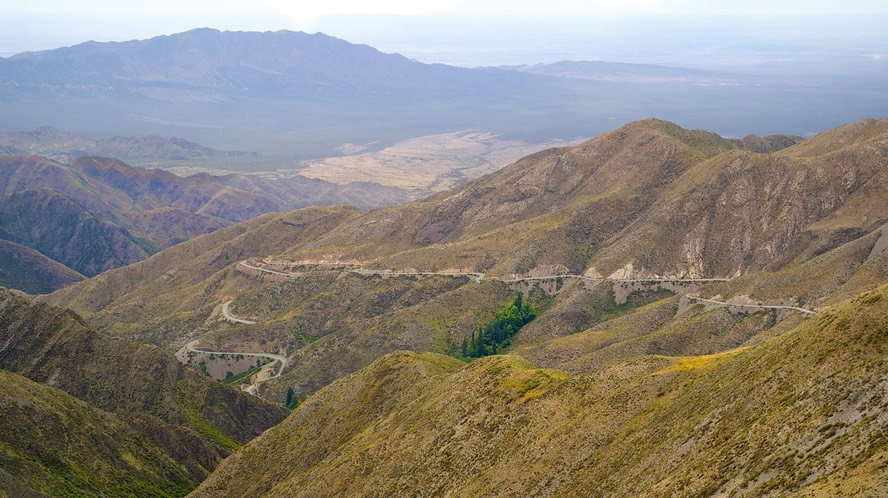
Afterwards we went on to Uspallata, still very high in the Andes, a pretty little town best known for their poplar trees (Lombardy poplars, I think); it was grassy and green and the folks were friendly. (We have continued to see these poplar trees everywhere we have visited in Argentina, if there’s enough water for them to survive.) In Uspallata we had our first encounter with the Argentine mid-day siesta. We are finding the towns close down after lunch and don’t get going again until late in the afternoon (sort of 1:00-5:00 at its most extreme). So the bank was closed (even the ATM). But the restaurants are all open; so we had a delightful lunch that included (for one of us) chivito – roast kid. The other guy had a pasta dish. Both quite happy.
After spending a quiet night in Uspallata, we hit the road for Mendoza, well known for its wine and pretty countryside. There are two roads down out of the mountains: Rte. 7 is the main road, and then there’s this back way that winds down and around and is really wild. We of course opted for the wild ride. We had a lot of fun; great views, no folks, tons of wildflowers (broom and wild roses in particular), parakeets dashing between the trees. It was neat.
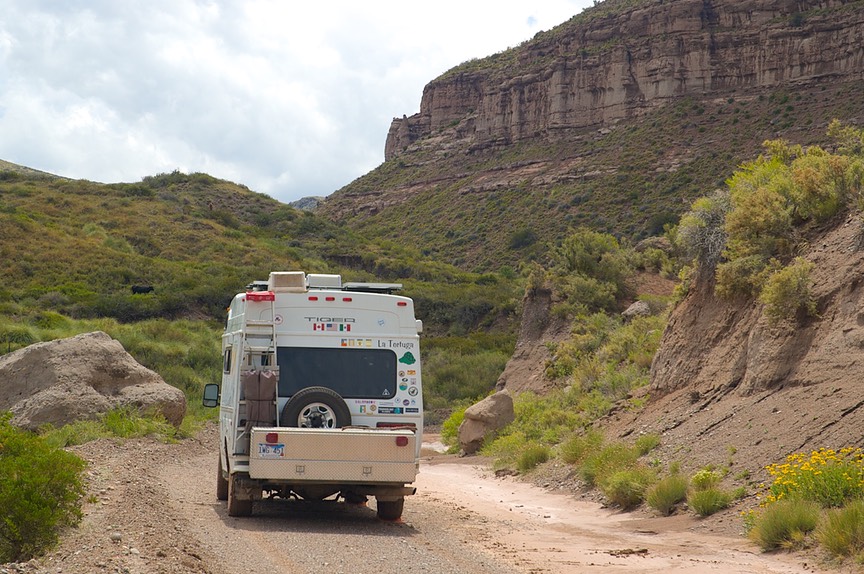
Well, Mendoza. Everybody loves Mendoza. More bodegas (wineries) than you can shake a stick at. Good food, shopping, happy times. Yeah, but too big. And kinda scary. We hit town, wanted to go see stuff, and were promptly told by at least three very kind strangers that we didn’t want to carry that camera out in the open did we? And to please be very careful. Made us uncomfortable. There are several campgrounds in a huge park in the city; very expensive (and we found out afterwards that people were getting robbed there regularly). We asked at the police station, and they let us park in front of their station for the night (that was great, actually; the station was right in front of a neighborhood park and was delightful). We had business in town, and needed to be there, but weren’t happy.
The next day, a Thursday, we got some business done, and contacted the family of a dear friend of ours (again, Mabelle, many-many-many thanks) who were expecting us to come and visit. They met us and guided us to their home in a suburb. They were delightful and gracious. We spent several days, learning about Argentine life and enjoying their company. They have a small second home closer to the mountains, and we spent part of the weekend with them there; this included meeting lots of neighbors and having a traditional Argentine asado (kind of like a BBQ). I also was introduced to the delightful tradition of maté. It’s not fair to call this sort of an Argentine version of the Japanese tea ceremony, but that will give you some sense of what happens. I loved it.
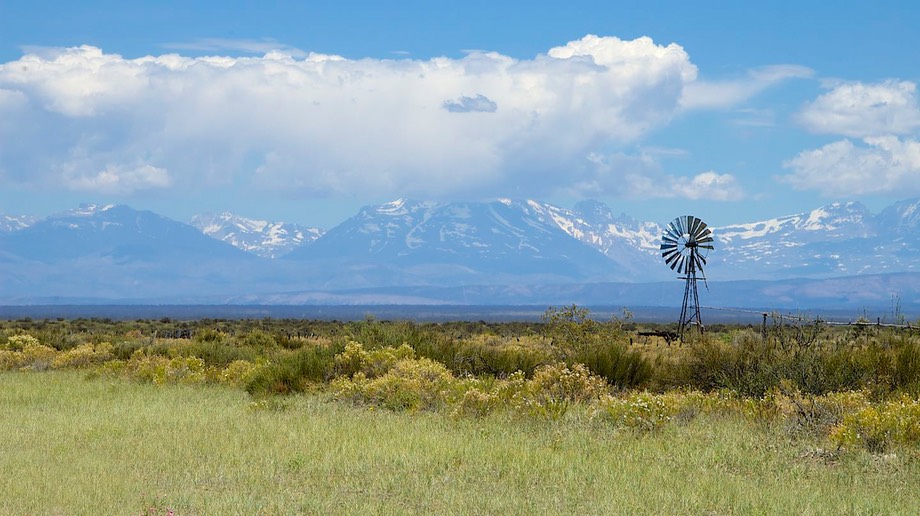
We were in a very productive area, and the offerings were superb. Graciela and Hernan are tucked away in a small rural community that has been there for many years. The trees are huge and abundant; many of the neighbors have large gardens, both flowering and producing. Large fruit trees, all producing; the cherries were ripe and delicious. Irrigation ditches everywhere. As with so many areas under cultivation, the land appeared to have been reclaimed from the high desert. It made me wonder if this is similar to what we would see in Israel. (Any thoughts here, Tess or Hana or Lina???)
Reluctantly, on Sunday we waved good-by to these great folks and hit the road again, heading further south. We left armed with honey from a neighbor, suggestions on great mountain lakes to check out, and introductions to other folks along the way.
So what do we know about Argentina so far? Admittedly, at this point we’ve only been in the mountains and one metropolitan area (greater Mendoza is over a million people). We know they take siesta very seriously. Their towns are old (but so far not colonial), and are filled with tremendously huge trees to ward off the sun and heat, making their parks delightful (and well used). They are very proud of their traditions and their European heritage.
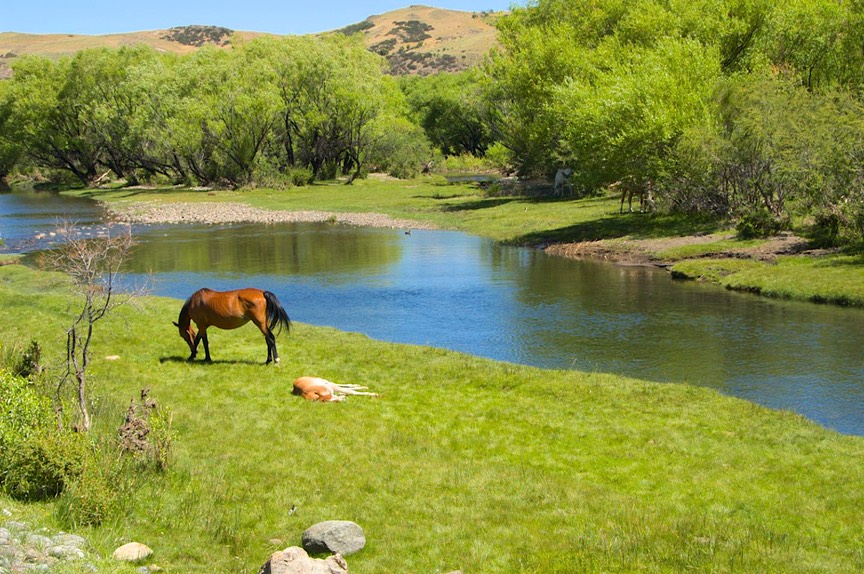
There are tons of old Ford Falcons and a few Plymouth Valiants and Chevy IIs on the streets, some in good repair, others looking like fugitives from Cuba. In the states, these cars date from the early sixties, but styling variations indicate that down here they must have been produced until around the mid to late seventies. Lombardy poplars are ubiquitous anywhere they will grow. We’ve seen our first Wal-Mart (whoop-de-do) since we left Mexico. The fresh fruit is fabulous. Diesel is the cheapest since Ecuador. All of the domestic animals we see are healthy-looking, large, clean, and beautiful – horses, cattle, sheep and (most of all) the goats. This is all very good; we are having a good time, despite the usual assortment of issues (stay tuned, she said). We have also confirmed that Argentina is as well known for its splendid chocolate as its (equally splendid) beef. But also – no decent cheese. (We really like cheddar cheese; we haven’t been able to find it since who knows when. Each new country gets a thorough scrutiny, and we may be able to find something that will “do,” but not good cheddar. Whine.)
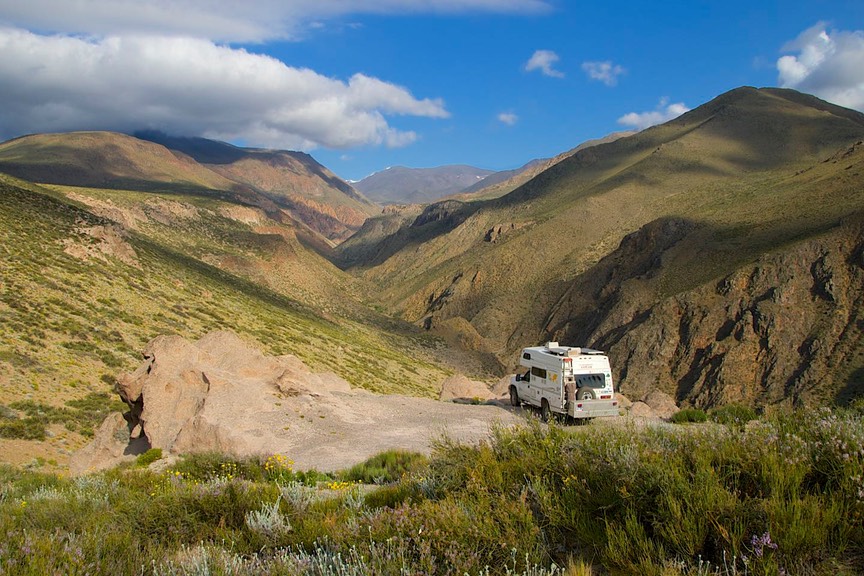
But onward. To orient you concerning Argentina, and to over-simplify, there are two Route 66-type “mother” roads going north-south in this country: Route 3, which runs from Buenos Aires to Tierra del Fuego, on the east (Atlantic) side; and Route 40 (the famous La Quarenta) in the west, running the length of the country, paralleling the Andes and somewhat east of those mountains. To keep it simple, you can get to the bottom either way.
We were heading south from the Mendoza area, on Route 40. Not really, because we wanted to use secondary roads where possible, but we’re keeping this simple, right? So. We wanted to visit a preserve, at Laguna Diamante, into the mountains. We trucked on up this dirt road through this very pretty area, heading for the lake. We got to the ranger station and found that the road on up to the lake was still closed because there was too much ice and snow on the road. (We were learning that we were still a little early for the summer season.) No problem. They showed us a side road we could take that would lead us to an overlook of an enormous, really cool canyon (oh, darn!) and we could camp there. This is what we would call high desert, by the way, and it is in full bloom. In Argentina they are called steppes. We spent two nights enjoying the incredible view and the lovely flowers – yellows, blues and whites. We like this!
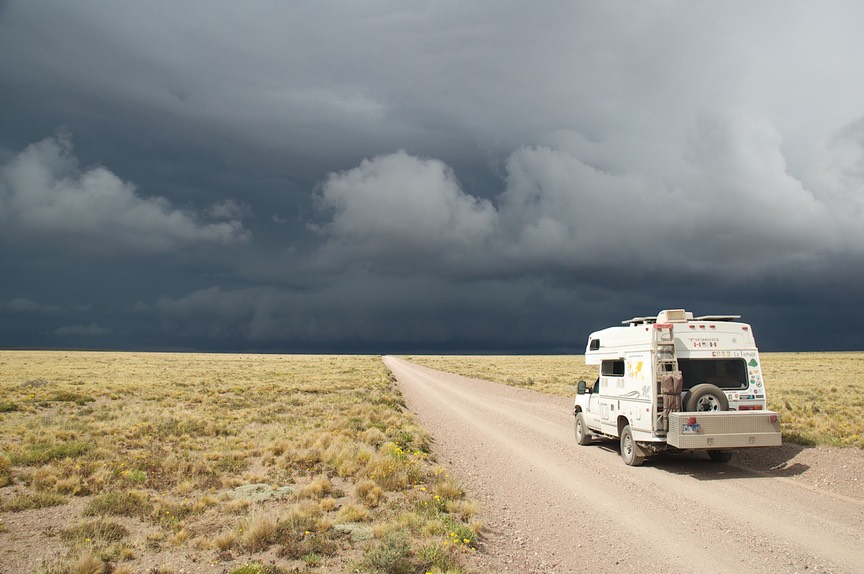
When we took off again, the sunny weather we had been enjoying rapidly disappeared. We were in open country and we could see a long, long way ahead where the clouds kept getting darker and more threatening. Not a big issue; yes, we were on a dirt road, but it was flat and straight, and nothing difficult appeared on the map. Reached a first arroyo. Rick says, no problem; road’s dry. But sure wouldn’t want to go down this steep and narrow and twisty road if it were very muddy. Down the second arroyo; ditto comments from commander-in-chief. Well, then it rained; and then it hailed – lots. Hmmm. Let’s see what’s up ahead. Rain and hail stopped. Great. Long and flat stretch and then third arroyo; round the first corner. Oops; knee deep in mud. Damn! Again? Yup. So we stand there and say, “Well, that happened.”
But we were much better off than when we were stuck in Colombia. We were able to get through the first bad section to a place where we weren’t in the middle of the mud and were on a fairly level stretch of road. And then we sat and waited in hopes the road would dry out again. About three hours later, Rick turned La Tortuga around, gunned-er, and splish-splashed his way back up the hill, fishtailing all the way. Kathy walked (have you ever been a passenger in a fishtailing car on a narrow road with a significant drop off on your side?). Nightmare avoided. Discretion dictated we make our way back to pavement. We didn’t know when it would be dumping water on us again. So we did just that, staying the night in tiny Pereditas, about an hour away, where friendly police were happy to have us park in front of their offices.
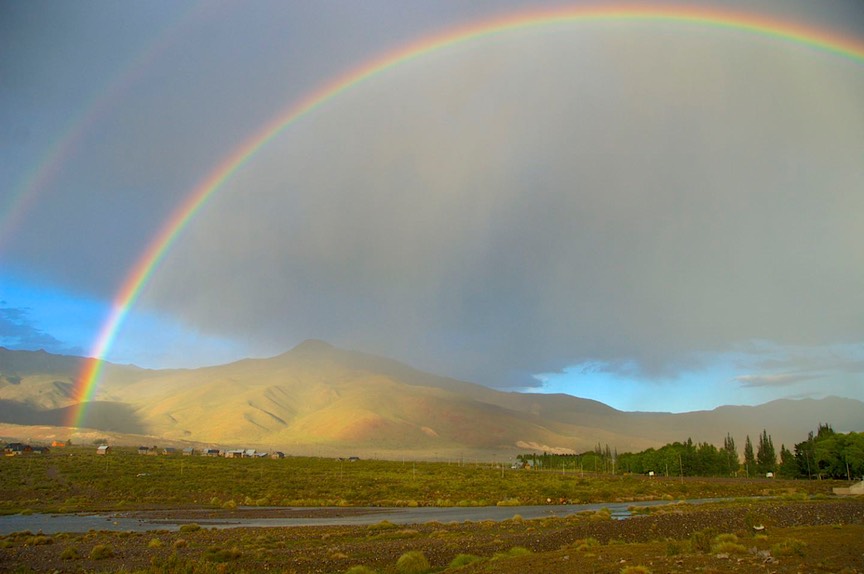
The next morning, we discovered we had a new problem – the inverter had quit on us. Rick took the thing apart, poked around, and finally determined the inverter had flaked out on us for good. Now the inverter is important. For you RV people, inverters, of course, mean you don’t have to run the generator for most stuff. We do for baking, but not otherwise. The inverter runs the microwave, and (most importantly) charges the batteries on our computers. So, “Well, that happened.”
We needed to figure out what to do. We also needed to get serious about finding some propane. Since we’d entered Argentina, we hadn’t been successful. (Chile had been easy, as they use propane as an alternative fuel for autos. In Argentina they use natural gas.) We are sure we could have eventually found it in Mendoza, but we weren’t there long enough to pursue all the avenues necessary. We needed a distributor, and that means more than a burg like Pereditas. The closest large city was San Rafael. We hadn’t wanted to head there, just because we try and stay out of large towns, but we were getting quite low on propane. And, we figured that San Rafael was a good place to get to a phone and order a new inverter.
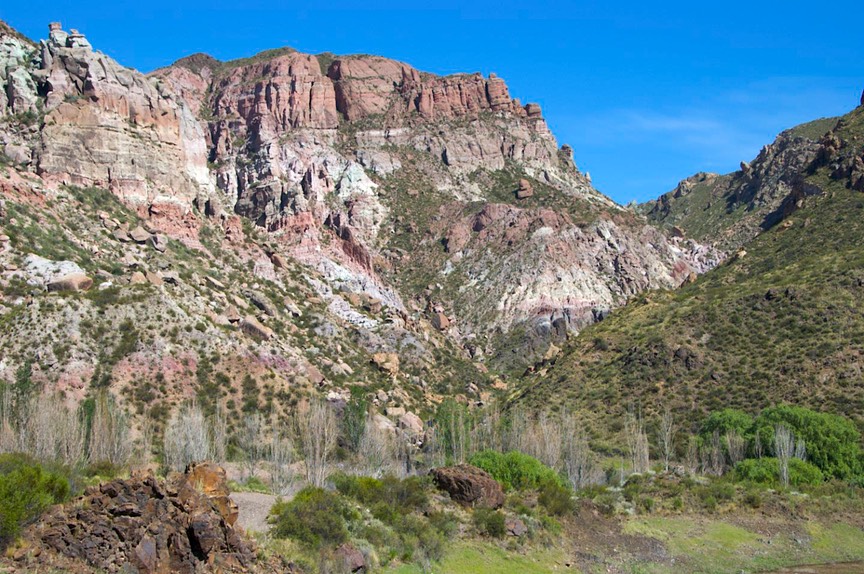
Arriving in San Rafael we started asking around and following up on leads for propane. As we did so, we were noticing that we really liked this city of about 100,000 busy and contented folks. They were working hard to have a nice, clean place to live. There were nice parks, a wide and friendly main street or two, and we saw evidence that good ice cream was available. Lots of people were riding their bikes around town. We even found a very nice restaurant with pretty good wi-fi that was happy to have us spend a couple of hours on our computers while we had a long and leisurely lunch.
Mid-afternoon the next day, we finally got squared away on propane. The fellow told us the truck was coming in the morning, and we should be there about 7:30. Needless to say that estimate was optimistic by about seven hours. Anyway, we puttered around town and got settled for the night.
The inverter? We ended up ordering it through our solar guys in the States; the inverter was to be shipped to us from the manufacturer in Canada. Piece of cake. Not really, of course, but it has been ordered and is being shipped to us in El Bolsón, further south. Got that sorted out and headed for ice cream. Now all we have to do is try and catch up with it as soon as it arrives, and monitor the tracking to make sure it doesn’t get hung up in customs. So. While we messed with inverter issues, and chased down propane, we made friends with the folks at the restaurant (Hot Pollo on Yrigoyen) where they let us sit and use wi-fi. We’re friends with the folks at the Locutório who have the international telephone we’ve been using. We’re friends with the ice cream parlor girl (Bernalú’s Helado Artesanal, also on Yrigoyen, if you’re in the area). Nothing more we can do here. But we ended up liking San Rafael a lot, and would be happy to visit again some day.
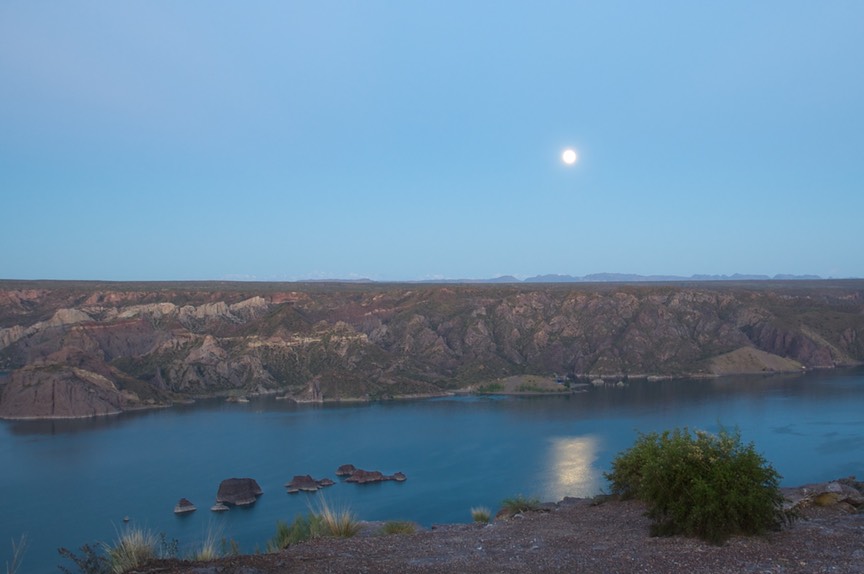
Heading out of town, we followed an excellent recommendation and took a back road, heading southwest along a river road that wound through a lovely canyon and took us past a total of four dams and through at least three tunnels. The arroyos had flash flood warning signs, so we were pleased it wasn’t raining right now. It was a beautiful drive and we felt good about stuff for the first time in awhile. We spent the night at an overlook above one of the dams, in solitary splendor, enjoying a terrific lightening storm, followed by clear skies, stars, and the full moon. The next morning one of us leapt out of bed at the crack, and took a stunning picture of the moon and its reflection in the waters of the lake behind the dam. Awesome. In case you might be wondering… Rick’s comment was, Leaping? There’s no leaping in the morning.
Starting out the next morning, we were commenting that the landscape looked very much like the western United States deserts. Rugged, barren and dry. Everywhere we have been in this country the landscape seems familiar. Much of it looks like the California foothills. The mountains are bigger, of course, and not all of it is the same. But there is much to point at and say, “We’ve seen places like this before.” Cool.
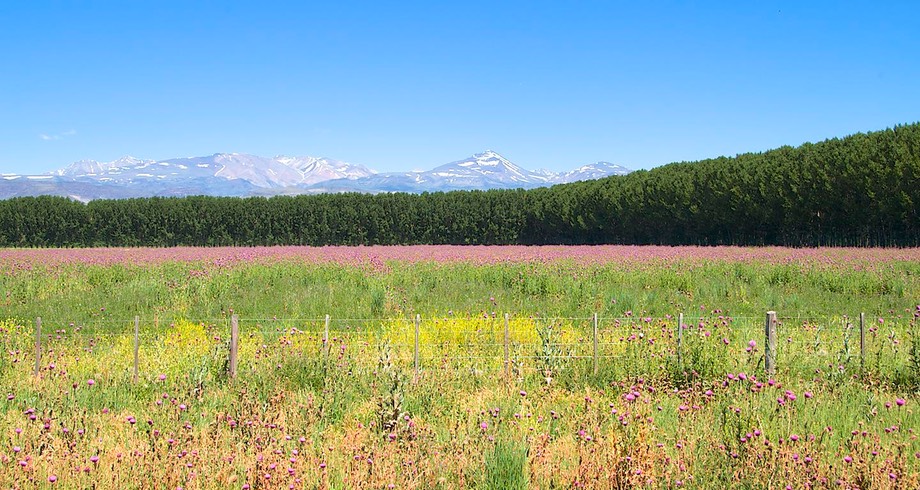
After our detour, we rejoined the Route 40 road and continued south. The fields were full of sheep and goats, hay (in bales), windmills, or just high steppes. A bit north of Malargüe we detoured into the mountains again, this time to explore a road leading up to the Las Leñas ski resort. We were curious about skiing Argentina-style. Looked like any other ski resort in the summer time – nothing going on and nobody there. But we really enjoyed the scenery, and spent the night along a river running through the canyon.
The next day we tried, without success (even though we followed every sign quite carefully) to find a reserve that was a wetlands (flamingoes supposedly were in residence); no such luck. Bummer; and it was suddenly getting much warmer. Summer had hit, we guessed. Moving on, we found ourselves in the strangely-named small town of Chos-Malal (never found out why). Pulled up at the edge of a pretty little park (actually, this is a charming small town, and we were very well treated here). Rick looked at the front of the truck and noticed that the engine hood was all wacky with one side sticking up about four inches. Investigating, he discovered one of the pivot points of the hood had broken. Local folks guided us to a welder (continuing our world tour thereof….); we waited for him to come back from siesta, and had the break welded. “Well, that happened.” An ice cream cone later, we settled in at the park for the night.
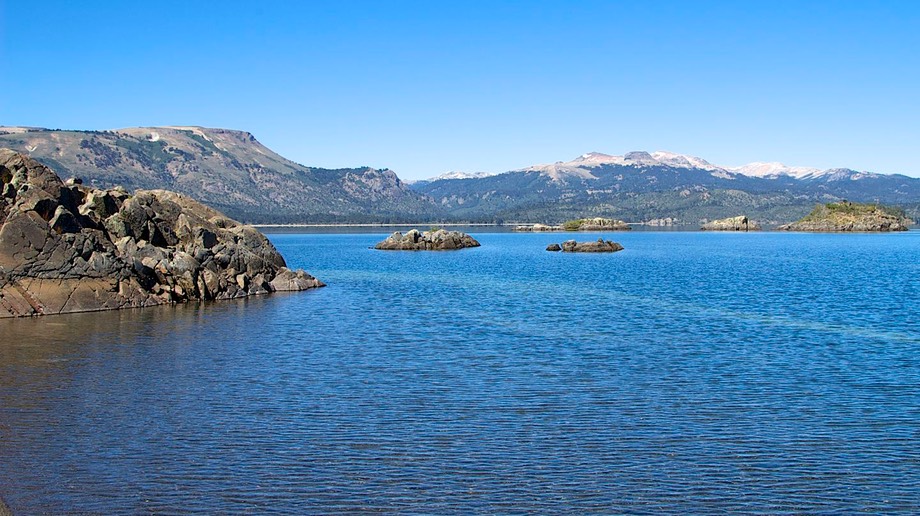
We were still moving south. More and more frequently, we would see gauchos on horses leading pack animals and moving large herds of goats along the road. They patiently move aside for us, then the herd swings along again. We surmise they are moving the critters to summer pasture.
Suddenly, we crossed the Rio Colorado and officially entered Patagonia. We high-fived it, grinned, and kept on our way. It was like crossing the 60th parallel in northern Canada. And…we looked at the calendar. It was just a year ago today that we left the United States and headed south into Mexico, on the first southern leg of our journey to the bottom of South America. Awesome, dude!
We stopped briefly in Zapala for supplies and happened on a really nice little bakery, and then swung into the mountains again, this time to check out Lago Aluminé. It was everything we had hoped for: a beautiful lake in sight of the Andes, lots of birds in the area, clear and sunny skies. We had our first experience with Argentine campgrounds that night, and weren’t disappointed in this aspect either. The one we chose was clean, had plenty of trees, and a lake view; what’s not to like. Well, the trees were a little low for us, but we found a spot; and had a quiet night.
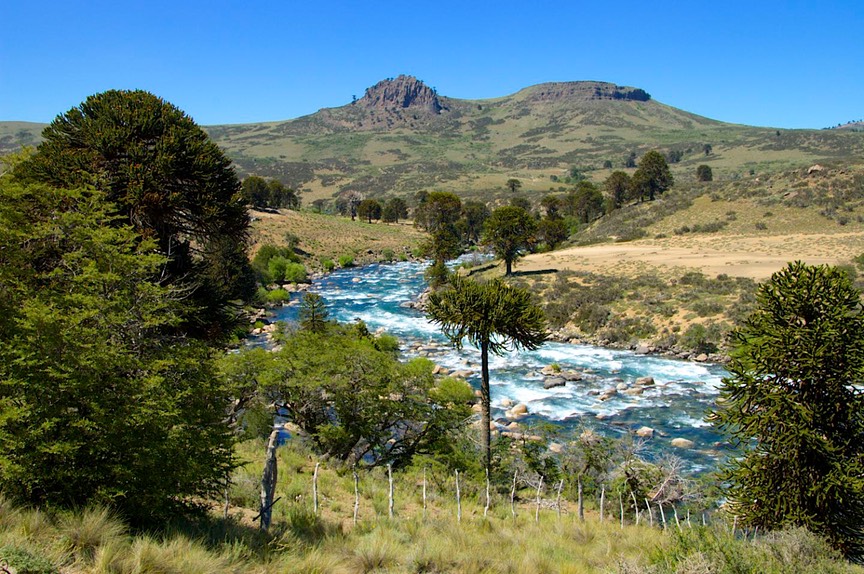
Next day, we followed the Rio Aluminé as it wound south through a beautiful canyon, headed for Junin de los Andes. We detoured into the high mountains, however, before we got there. We had seen a road through NP Lanín up to the Chilean border (we didn’t get quite that far), which would pass to the north of Volcan Lanín, the largest peak anywhere near (highly recommended), and we wanted to see it. We arrived in the area late in the afternoon, found a great view spot under a monkey puzzle tree (very famous in the area), spent the night and awoke to incredible vistas of the volcano. Too cool. Many pictures later we retraced our steps down from the park, and rejoined the road to Junin de los Andes.
We didn’t spend a lot of time there, mostly looking for wi-fi and some fruit (mixed results), but really enjoyed this pretty little mountain town. It looked a lot like so many we had seen in the United States. This is the self-proclaimed trout capital of the province, and the setting is lovely. The town has roses in bloom in the public areas, many trees, and cutesy wooden signs everywhere. It would like you to stop and spend a few days. On our beautiful sunny visit, it was quite charming. We bought lovely fruit, but couldn’t get what we wanted from the local internet folks. So on we went, heading for San Martín de los Andes.
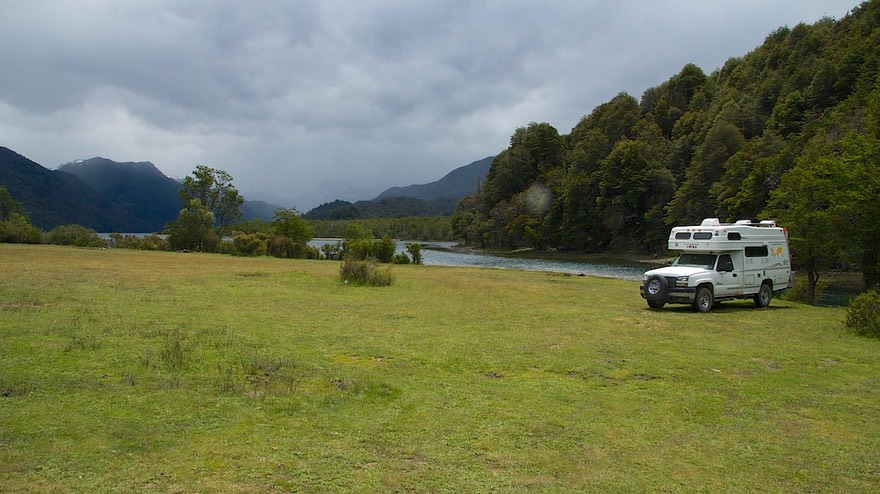
Arriving there, we confirmed what we’d been told: San Martín de los Andes is bigger and more developed (and much more touristy); but just as pretty. San Carlos de Bariloche is the next town down the road, and it’s supposed to have gone from charming to way-too-much; San Martín is trying to stave that off, and is an easy town to like. We enjoyed wandering through the little shops and checking out the fancy jams and olive offerings and such; there were plenty of good restaurants (we found one for lunch and then sat in another for the afternoon doing wi-fi and had dinner there – yummy and a good opportunity to catch up). We even had the laundry done. We felt good about being here and were very happy we had visited.
Upon leaving, our plan was to keep heading south, toward Bariloche, taking a winding road called La Ruta des Siete Lagos, past several (seven!) lakes and through reputedly gorgeous country, before arriving at our next destination. Bariloche was important to us for a couple of reasons. We had someone whom we wished to visit, and there was a good chance our new inverter would pass through there and we might be able to intercept it at the local Fed Ex office. Time would tell!
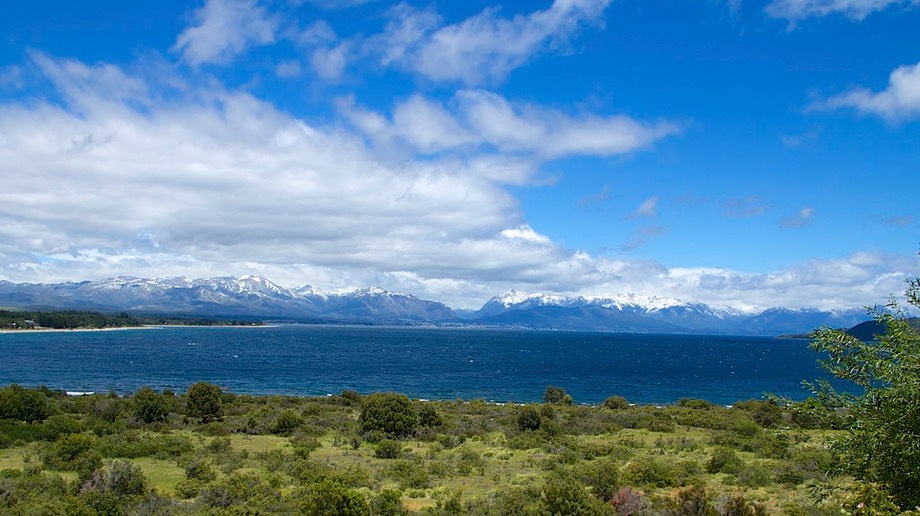
We stopped at a small lake in the Nahuel Huapi National Forest for two days on our way. We had free camping alongside Lago Villarino in an open meadow, with cows to keep us company and mountains all around. Plenty of wildflowers to enjoy, including – for the first time – foxglove. Also two German couples we chatted with. We would have spent more time except first it rained a bit, then hard, then dropped into the 30’s and turned to hail. The next day it was still nasty (and there was fresh snow on all the peaks around us), and we wanted to get to Bariloche so we moved on.
As with all anticipated plans, we had mixed results in town. First though – Bariloche and environs is an incredibly beautiful area. We had no trouble confirming that it deserves every nice comment made about it. Quickly, we found ourselves in familiar surroundings – Lake Tahoe at its former best. Bariloche is on the south shore of Lago Nahuel Huapi, blue and crystal clear and with a mostly rocky shoreline. The lake is ringed with high mountain peaks; just for us, they were covered with snow from the recent storm.
There are several small communities, all of them resort-oriented, along the shore, but the main town (city, actually) is Bariloche. Plenty of good restaurants, shopping, “tourist infrastructure” as they say; it’s still a great destination. And there were tons of folks there to enjoy it with us. You have to remember that for us, as North Americans, the holidays are a two-week period. For South Americans, they are the beginning of the summer vacation period, which lasts for two months or more. And summer, up here, is a relative thing. At lower elevations it is very hot (think California’s Central Valley in July), but in the mountains it is cool and breezy. Absolute heaven. It seems that Bariloche is a destination for end-of-school outings, too; we saw absolute gobs of color-matched high school kids trooping from pillar to post every few minutes, doing all the things high school kids do world-wide. We enjoyed watching them.
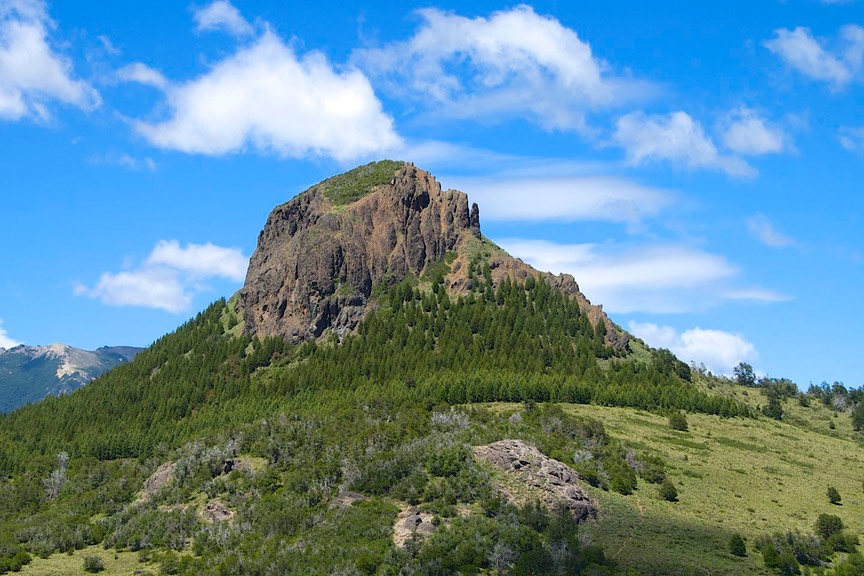
We had less luck with the inverter. I swear – never again will we have anything but plain ole’ mail sent to us in a foreign country. Inverter had arrived in Argentina, but was stuck in customs in Buenos Aires. (I think they thought it was a bomb.) Push-pull-push-pull. Finally were told (after two days) it had now been handed off to the contract company (no Fed Ex in the Andes) that would be delivering it to El Bolsón (the next in a chain of delightful mountain resorts, and an hour or so away); talked to them; assured them there would be someone to receive it when it arrived; and found out it should be there the Monday after Christmas. Progress, finally, we thought!!!
Had a delightful time meeting some friends of a friend, who turned out to be absolutely amazingly fascinating people. A wonderful lunch. And just in the nick of time. Rick had a bad tooth and needed a dentist. They found one for us, and we met with her for an exam. She said root canal; we opted for a week of antibiotics and would meet with her Monday after Christmas. So we can, again, say, “Well, that happened.” Life goes on. “Monday after Christmas” was going to be a busy day! Folks back home often ask what we do if something health-related happens, and this is it. Ask around, find a little help here or there, locate a doctor or dentist, and things will be fine. It turned out that in this particular incident neither the doctor nor her receptionist spoke any English. On realizing that Rick was a touch uncomfortable at not being able to understand what was being said, they were kind enough to call someone who could interpret for him. Nothing really out of the ordinary… except that the person they called was a colleague, a fellow Argentine dentist who just happened to be practicing now in ENGLAND! She graciously spent time explaining the problem and the planned procedure until everyone was comfortable.
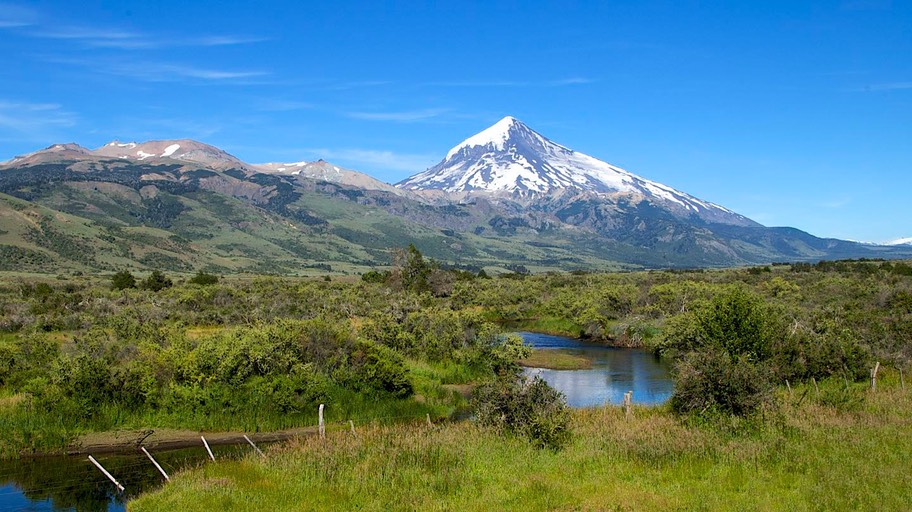
In the meantime we had a few days available. We could have found a quiet lake and just stayed there. But we opted to hop (“opt to hop” – now that’s a weird thing to say!) across the border and check out the Chile side of things. Two reasons: First, we had been having a little trouble finding propane (although not trying hard yet) and were getting low again; we knew it would be easy to locate in Osorno, the big Chilean city directly across from us. (Shouldn’t have needed it, but without the inverter we were having to run the generator much more than usual, and thus using more propane.) The second reason was that Chile has much better grocery shopping, and we were low on or out of a bunch of stuff we couldn’t find in Argentina. Lots of shopping in Osorno. So over the border we went.
This time I was better prepared for the B.B.’s, and coasted through pretty smoothly. One interesting thing was that they didn’t even ask me about some of the stuff the B.B. at the Peru/Chile border was a real bird dog for. Hmmm. Afterwards, we had a quiet talk, and Rick convinced both of us that “B.B.s” was pretty harsh; perhaps we could call them the Aduana Iguanas instead. Okay, she said… for now.
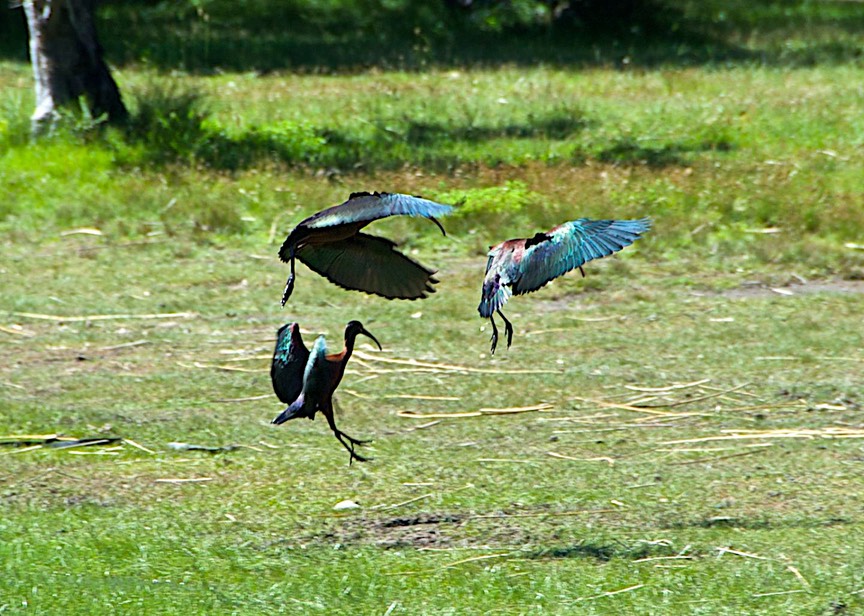
Coming down the west side of the Andes, we were immediately struck with how bucolic and green the countryside was. We thought we were in Wisconsin! Low rolling hills, cattle grazing, raspberries for sale along the country roadside. Delightful. We spent a quiet few days enjoying the countryside, then hiked back over the hill again, back to Bariloche. Now here’s a wild one: at the border, no one even did a produce inspection; go figure!
Back in Bariloche things got pretty wild for a couple of days. We arrived on the Monday after Christmas, as expected, and Rick prepared to face the music on the dental front. We spent a couple of hours wandering, taking our computers to do wi-fi and enjoying the town, came back to La Tortuga in time to drop stuff off and go to the dentist, and found out the rig had been broken into and all our camera gear had been stolen, along with our secreted extra money and the electronic computer backup devices. We had done everything right (the truck was thoroughly locked, in a well-traveled area, all the usual), but they’d broken the lock on the driver’s side. Probably there a total of 2-3 minutes, and then gone. “Well, that happened”! was a little bit harder to say this time!
A couple of unhappy puppies, that’s for sure. Not even enough ice cream in town to cover this disaster! We spent time with the police, Rick visited the dentist (who decided the antibiotics had done all the work necessary, and goodby – slightly weird, but appropriate to the day), and, somewhat shell-shocked, we went on to El Bolsón to pick up the inverter.
Upshot on the inverter front? Argentina says it is black-listed in this country and cannot be allowed out of customs. This after many phone calls and intervention by an acquaintance who spoke Spanish calling and trying to get it released for us. So….that happened, too.
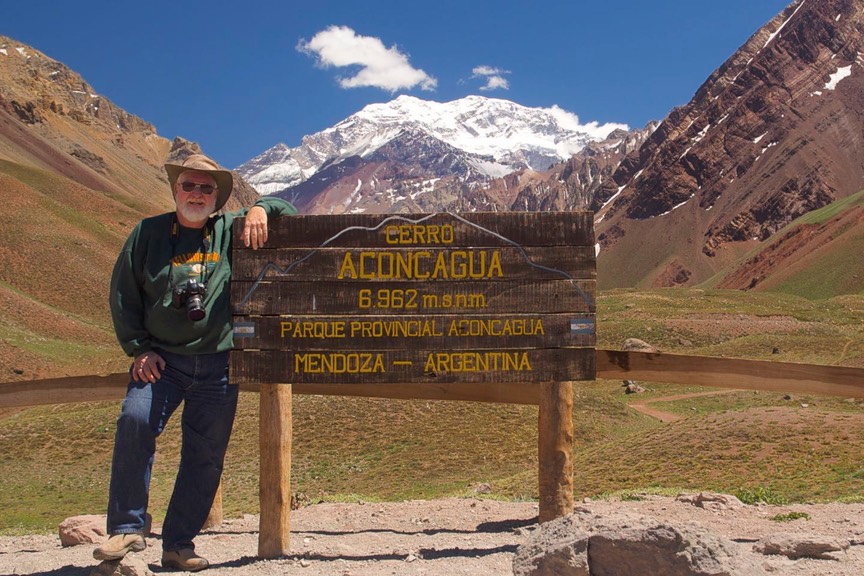
So, we have gone back to Chile; everyone says you can buy “stuff” here. We have found a replacement (quite a bit smaller) inverter, and have actually ended up in Santiago buying new cameras. We are now headed back for Argentina, resuming our trek to the bottom of this incredibly lovely, exasperating, sometimes very difficult continent. We continue to be very happy with our chosen path in life, although there are sometimes difficulties along the way. But you can get killed just trying to cross the street, too. Life is just life. We are, however, hoping that 2009 will get off to a better start than 2008 ended!
Our best to all of you for the new year; we have heard from many of you in the last few days, commenting on and responding to our self-portrait and request for e-mails. A big thank you to y’all; we love you and want to know what you’re up to. Keep those cards and letters coming!
Rick and Kathy
PS-1. We are unfortunately a bit light on the picture front at the end of this message as, no surprise here, when our cameras were stolen we each lost some un-downloaded photos that were still on the memory chip. Damn!
PS-2. Forgot to tell you – when we crossed back into Chile this last time, after everything that had just gone wrong, those damn Aduana Iguanas became Border Bastards again – they ransacked my refrigerator and took away a whole bunch of things no one had even asked about at any other time since we had entered South America! Would you believe it?
PP-3. Oh, for any of you who happen to enjoy our somewhat eclectic movie references (we certainly hope there are some of you out there), our theme for this article is taken from the David Mamet classic, State and Main, where “...that...” happens to Alec Baldwin.
Click the link to see more photos from Central Argentina.